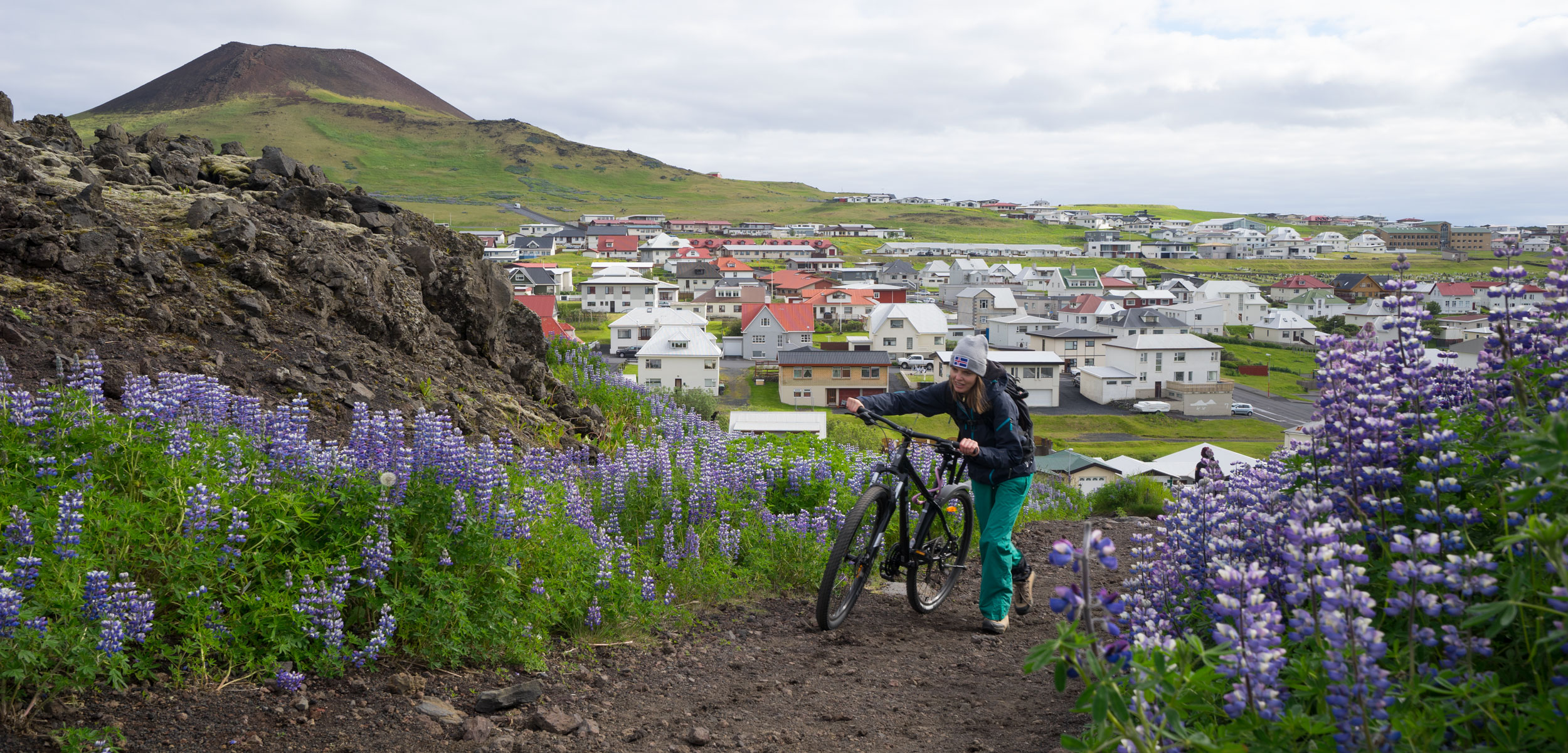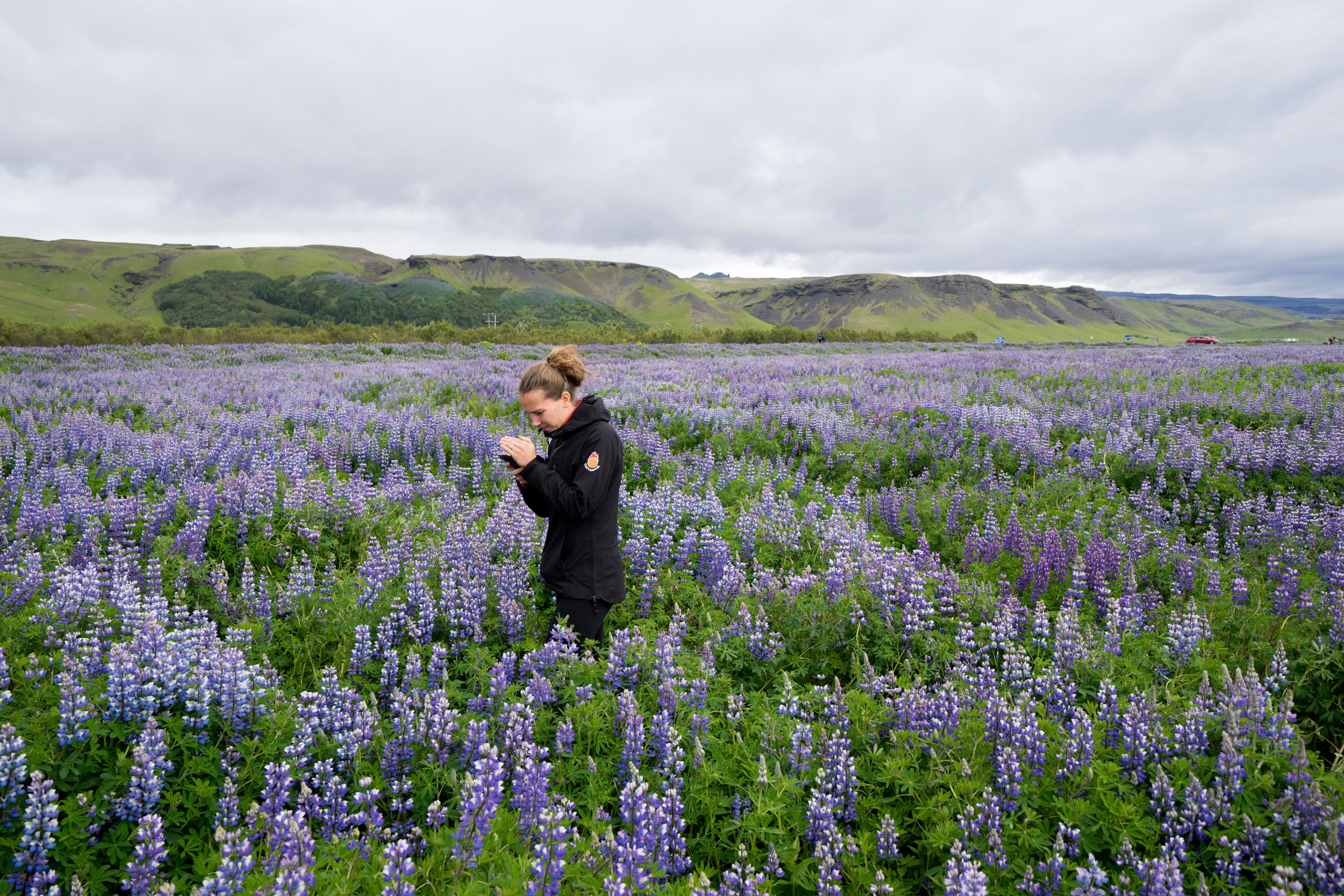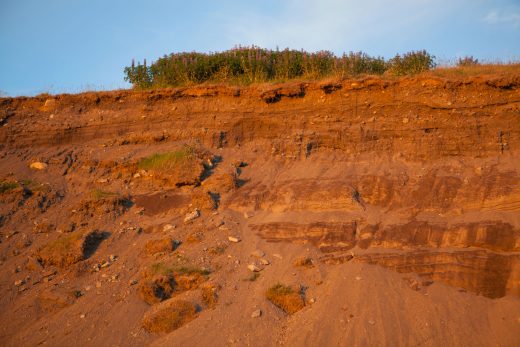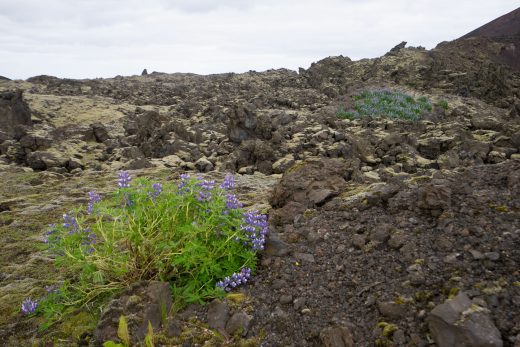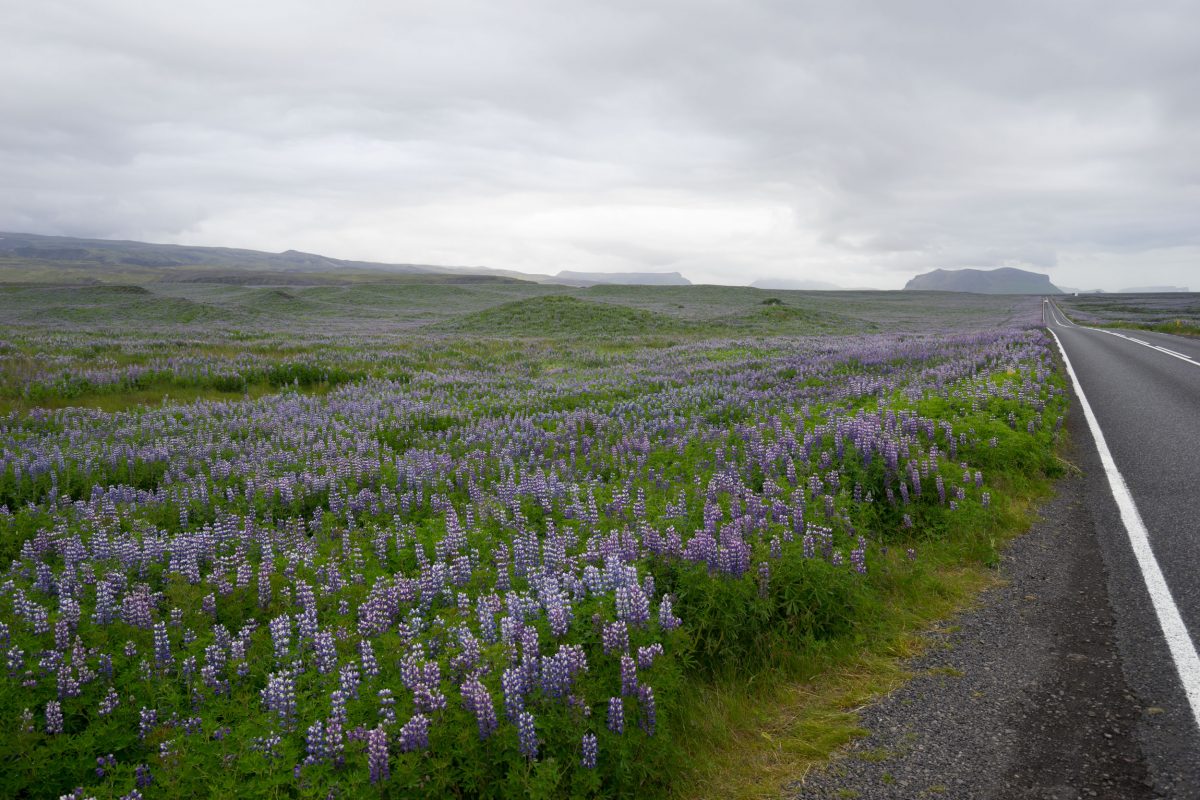Why Iceland Is Turning Purple
Buoyed by climate change, an invasive plant is taking over the landscape of the island nation.
Article body copy
Two years before stepping on the moon, Neil Armstrong went salmon fishing in northern Iceland. A picture of him, standing by the river, is exhibited in a regional museum, but the image is so small I first assumed it was just a snapshot of leisure life in the 1960s. Smiling faintly as he holds a fishing rod, the 36-year-old Armstrong could pass for a local—until you consider the baseball cap and fancy aviator shades. And the four layers of clothing.
Other prospective spacemen were around too, living in NASA training camps in Iceland’s interior. It was summer, and the constant daylight obscured their ultimate destination. In the middle of Iceland’s highlands, NASA had found a parallel lunar landscape: no vegetation, no life, no colors, no landmarks. The entire area was essentially a natural gravel field. The would-be astronauts took advantage of it by splitting into teams and playing soccer to unwind after training days, using rocks to mark the goalposts. Walking to the nearest tree would have taken the men days, across the Hólasandur, the black sand desert, and toward the northeastern coast. Even then, the tree, weather-beaten like everything on the eroded North Atlantic island, wasn’t much taller than Armstrong’s fishing rod.
The term “lunar landscape” is popular among today’s tourists when captioning images of boundless Icelandic deserts, shaped by volcanic eruptions, covered in different shades of lava. In the foreground of those photographs, however, is often a peculiar purple alien: the Alaskan lupine. This plant arrived on the landscape not long after the astronauts, and was embraced as an efficient cover for eroded land. But the experiment blew up in Iceland’s face and left a permanent purple mark. Considered an invasive plant today, the lupine threatens not only the existing flora but also the barren volcanic interior, often described with words echoing Buzz Aldrin’s first observation about the scenery on the moon: “magnificent desolation.”

American legend Neil Armstrong trained for the first moon expedition in Iceland, before lupines changed the country’s lunar-like landscape. Photo by Sverrir Pálsson, courtesy of the Exploration Museum
The once-black Hólasandur sand where the astronauts traveled is a purple field today. As the climate changes, the lupine spirals toward places previously protected from the plant by cold temperatures and low rainfall. For some Icelanders, however, this purple flower is welcome. In a very visceral debate, the fight for Iceland’s color has spurred a new form of identity politics. Tensions rose this past summer when communities in eastern Iceland, the faux lunar landscape, called on their residents to join hands and outlaw Iceland’s alpha plant. Even if we all agree lupines are evil invaders that must go, could we actually eradicate them?
Lupinus nootkatensis—known in its native Alaska and British Columbia as the Nootka lupine—is a member of the pea family. In gardening parlance, it’s a nitrogen fixer: it hosts bacteria that gather nitrogen from the air, transferring the gas to its root nodules. Plough under lupines (or peas for that matter) and the nitrogen is released into the soil, providing nourishment for the plants that follow. It’s a pretty and elegant solution to nurturing exhausted soil.
The Alaskan lupine arrived in Iceland in 1945, in a suitcase. What led to its deliberate introduction to the landscape began some 1,000 years before its arrival. When the first settlers disembarked from Viking ships over 1,100 years ago, two-thirds of the island was covered in greenery, and it had only one terrestrial mammal, the Arctic fox. The island’s first humans settled in with a shipload of livestock and adapted the agrarian lifestyle from home, cutting down trees and burning the wood, totally oblivious to the fact that Iceland’s soil forms more slowly and erodes much more quickly than mainland Europe’s.
Those early settlers would have hardly recognized the stark coastline the government hoped to rejuvenate when it formed the national forest service in 1908. By this point, Iceland was ecologically “the most heavily damaged country in Europe,” to quote celebrity polymath and author Jared Diamond. Wind erosion was, grain by grain, blowing the country out to sea.
The destruction continued unabated and in the mid-20th century, when other European nations were rebuilding after the Second World War, the Icelandic Forest Service was pondering human-induced destruction of a different kind; Icelanders had so heavily exploited their island home, logging the native birch forests and overgrazing vegetated land, that only 25 percent of the country’s original green cover remained.
The agency sent its director, Hákon Bjarnason, on a three-month mission to Alaska to gather plants and trees that he liked and thought could revegetate Iceland. The arrival date back home, stamped on his passport, November 3, 1945, marks the birth of our lupine saga.

Some communities have begun to eradicate lupines from their surroundings, worried they’re taking over favored berry patches. Photo by Egill Bjarnason
For the first three decades, the plant lived in green spaces near the capital Reykjavík. Árni Bragason, director of the Soil Conservation Service of Iceland, says it wasn’t until 1976 that the lupine’s seeds were actively collected and released into the wild, tasked with bolstering the country’s feeble soil. Lupines performed admirably and acted like fertilizer factories, purpling the landscape at almost no cost and without the need for special training: seeds could be collected by anyone, tossed into a hole no larger than a shoe’s heel and—abracadabra—the scenery eventually changed. Maybe forever.
Decades later, I had an inkling of what this purple flower had wrought on my compatriots’ psyche. There is a serious divide between Icelanders, and the wedge is the Alaskan lupine.
In 2006, I was standing at the entrance of a grocery store in Selfoss, southern Iceland, with a notebook and the cheapest camera from the Sunnlenska local newspaper. Here, I waited for people to partake in The Question of the Day, a column in which innocent pedestrians are prompted to articulate, for the record, a view on a contemporary issue they usually know next to nothing about and—after guaranteed intellectual embarrassment—have a portrait taken to accompany the answer. Environmental questions were always tough; no sane person visits the grocery store to discuss the death of our planet. But this day, I struck a chord with what seemed like a pretty lightweight query: what do you think about the Alaskan lupine?
Everyone had an opinion. Many of the people I questioned had witnessed lupine creep in real time. Drive the island’s Route 1, which connects the small nation’s cities and towns, in early summer, and it’s like barreling down a road paved straight through lupine fields, as if the flowers came before the road. They didn’t. Over the years, random people have picked up the forest service’s enthusiasm for the plant and haphazardly brought seeds to towns, valleys, and offshore islands. No Icelander has not gazed upon a field of purple. And many are lupine lovers.
The Facebook group Vinir lúpínunnar, Friends of the Lupine, with about 2,800 members to date, shows the diverse, widespread support for the lupine among Icelanders. Some members extol the virtues of the flower as a reforestation tool: trees planted alongside lupines benefit from the enriched soil. Once large enough, trees steal light from the almost-meter-high flowers, and ideally, over a roughly 25- to 30-year period, the lupines naturally recede once the soil is fertile enough for other things to grow. Other members embrace the lupine for its aesthetics, posting videos and pictures, never mentioning that the plant is foreign flora in Iceland.
The lupine’s friends are particularly enamored with before and after photographs. And, of course, their ardor is exploited. After visiting the group, Facebook bombarded me with ads for lupine herbal tea, sold in 1.5-liter plastic bottles for a mere US $19, which I suppose is a pretty fair price for something that purports to improve “poor blood circulation, Parkinson’s disease, and cancer,” among other things.
The people at the grocery store answering my question fell into either pro- or anti-lupine camps; there was no ambivalence. Most answers, however, were long and emotional, not dispassionately scientific.
The first two people told me anecdotes of lupine magic; how it prevented erosion and blowing sand and made it possible to plant trees. The third said the lupine had destroyed the view from his summer cottage. The fourth claimed to destroy lupine lands in his free time but was hesitant stating this publicly. Almost everyone predicted two different futures: one with lupines versus one without lupines. The fifth person, however, gave a long rant that I trimmed down to a single question, “Why didn’t anyone stop this?”
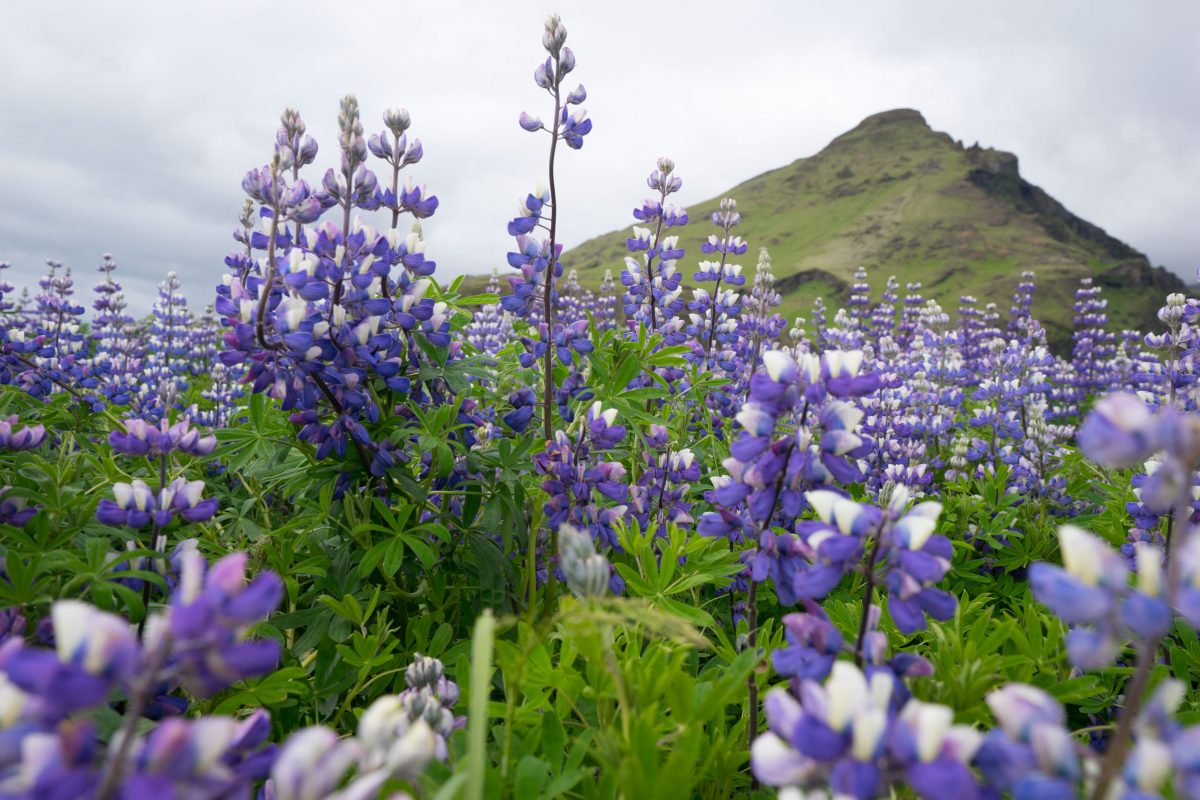
As members of the pea family, lupines infuse exhausted soil with much-needed nitrogen. Photo by Egill Bjarnason
The regreening of Iceland has become a balancing act: we want to retain the renowned splendor of our naturally occurring volcanic deserts, but we also need to revegetate what we’ve lost. The lovers and the haters each have valid points.
Lupines cover 0.4 percent of Iceland’s land surface, based on aerial footage estimates. That sounds meager, but considering the country’s afforested land cover only amounts to 400 square kilometers, that’s a lot of lupines. And while planted forest cover is predicted to reach about 1.6 percent in 2085 under the current forestation rate, the purple flowers could potentially spread into the double digits, aided by climate change and human activity. “Exponential growth is the nature of invasive species,” says botanist Pawel Wasowicz, who is the lupine expert at the Iceland Institute of Natural History. The growth curve, he estimates, will see a dramatic peak in the next two decades.
Few countries are as vulnerable to global warming as Iceland, according to the Institute of Natural History, as invasive species have enormous potential to edge out existing flora and spread into the highland interior, which is currently too cold and dry for most plants. This naturally occurring lunar-like landscape could, in other words, disappear. In about 30 years, under the current rate of climate change, the lupine could colonize much of the highland, suggests a research paper published in the journal Flora in 2013. Naturalist and former member of parliament Hjörleifur Guttormsson, who is 82 and one of the earliest opponents of the plant, says, “Everything but the glaciers are potential lupine land.”
Its ability to grow in poor soil has allowed lupine to spread rapidly in Iceland. Photos by Egill Bjarnason
“We are at the point of no return,” agrees Bragason. “The best thing we can do is reach a consensus about where the plant should be. That has been hard, too.” In Bragason’s opinion, the ideal lands for lupines are damaged coastal areas with natural borders like mountains and rivers. There, the positive effects can be both short and long term: preventing sandstorms and creating soil for reforestation. Near the Hekla volcano, where frequent eruptions over the centuries have destroyed a vast birch tree forest, the Soil Conservation Agency has successfully resurrected parts of the forest with lupine magic. Using native plants and fertilizers would have been slower and more expensive.
Few regions have the resources to prevent the great lupine land grab. Killing the plant, apparently, is a three- to five-year process. Typing lúpína drepa—lupine kill—into my search engine landed me on blogs peppered with militaristic phrases about the process. The lupine, it seems, makes its enemies among the public when it messes with their neighboring berry land. Armed with grass trimmers, communities in Iceland are joining forces to beat back the invaders. Their method is to cut lupines at the beginning of summer, before the plant forms seeds and when the root is likely to die from trimming. This past summer, three towns in eastern Iceland loaned out grass trimmers to anyone who wished to partake in the killing spree, an event planned as an annual assassination “until the plant is outlawed, at least from our nature reserves,” says Anna Samúelsdóttir, director of environmental policy at the Fjardabyggd municipality, which leads the eradication charge. Her efforts made national news because such coordinated missions, with high participation rates, are a new phenomenon in Iceland.
“People see how lupine land grows like a snowball,” Samúelsdóttir says. In fact, over a 15-year period, the plant has spread up to 35-fold in parts of eastern Iceland, mostly on land already vegetated with native flora. “Look down in the middle of a lupine field and you won’t even see the ground, the flower bed is so thick. Crowberries and blueberries and dryas—they’re gone.”
Meanwhile, on the lupine lobby Facebook group, Samúelsdóttir’s move to outlaw the controversial plant was received as a declaration of botanical warfare. “Cut them all they want,” one member wrote, hinting at the kind of guerrilla tactics the lupine activists employ. “I will just visit the same area with a pocket of seeds.” Another suggested eastern Icelanders’ lupine-free ambition was a testament to their xenophobia; they were suspicious of anything foreign born.
Nine of the 12 men who set foot on the moon between 1969 and 1972 first came to Iceland to study the geology, the idea being that it would help them understand the moon’s geology when they visited. NASA had originally drawn the parallel from images taken by a space probe orbiting Earth’s satellite years before; the lunar highlands (seen from afar as the lighter surface regions) looked like Iceland’s desolate interior. On July 24, 1969, Apollo 11 landed back on Earth with a geological sample—a slice of the moon. The resemblance to Iceland was superficial.
When the Indiana Jones-like forestry director Hákon Bjarnason arrived from his Alaskan endeavors in 1945, fresh off the plane, he told a reporter that with some effort, Iceland could look a lot more like coastal Alaska, with tall trees and lots of blueberry bushes. The two places had a strikingly similar climate. But, again, it turned out the similarities were superficial.
In hindsight, the overconfidence is understandable. In 1945 and the decades that followed, we were on a technological roll, an era in which we thought we could conquer nature, even defy gravity by launching men to the moon. No one could foresee the tenacity of a pretty flower, no one could foresee a purple Iceland.

